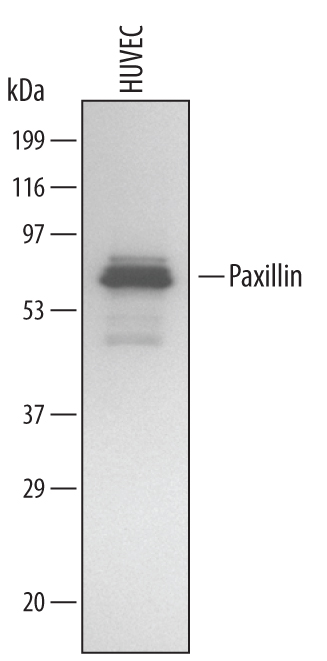Human Paxillin Antibody
R&D Systems, part of Bio-Techne | Catalog # MAB4259

Key Product Details
Species Reactivity
Validated:
Cited:
Applications
Validated:
Cited:
Label
Antibody Source
Product Specifications
Immunogen
Asn59-Ser274
Accession # P49023
Specificity
Clonality
Host
Isotype
Scientific Data Images for Human Paxillin Antibody
Detection of Human Paxillin by Western Blot.
Western blot shows lysates of HUVEC human umbilical vein endothelial cells. PVDF membrane was probed with 1 µg/mL of Mouse Anti-Human Paxillin Monoclonal Antibody (Catalog # MAB4259) followed by HRP-conjugated Anti-Mouse IgG Secondary Antibody (Catalog # HAF007). A specific diffuse band was detected for Paxillin at approximately 65 to 70 kDa (as indicated). This experiment was conducted under reducing conditions and using Immunoblot Buffer Group 3.Paxillin in Detroit 551 Human Cell Line.
Paxillin was detected in immersion fixed Detroit 551 human embryonic skin fibroblast cell line using Mouse Anti-Human Paxillin Monoclonal Antibody (Catalog # MAB4259) at 10 µg/mL for 3 hours at room temperature. Cells were stained using the NorthernLights™ 557-conjugated Anti-Mouse IgG Secondary Antibody (yellow; Catalog # NL007) and counter-stained with DAPI (blue). View our protocol for Fluorescent ICC Staining of Cells on Coverslips.Paxillin in HUVEC Human Cells.
Paxillin was detected in immersion fixed HUVEC human umbilical vein endothelial cells using Mouse Anti-Human Paxillin Monoclonal Antibody (Catalog # MAB4259) at 10 µg/mL for 3 hours at room temperature. Cells were stained using the NorthernLights™ 557-conjugated Anti-Mouse IgG Secondary Antibody (red; Catalog # NL007) and counterstained with DAPI (blue). Specific staining was localized to actin filament tips. View our protocol for Fluorescent ICC Staining of Cells on Coverslips.Applications for Human Paxillin Antibody
Immunocytochemistry
Sample: Immersion fixed Detroit 551 HUVEC human embryonic skin fibroblast cell line and immersion fixed human umbilical vein endothelial cells
Western Blot
Sample: HUVEC human umbilical vein endothelial cells
Formulation, Preparation, and Storage
Purification
Reconstitution
Formulation
Shipping
Stability & Storage
- 12 months from date of receipt, -20 to -70 °C as supplied.
- 1 month, 2 to 8 °C under sterile conditions after reconstitution.
- 6 months, -20 to -70 °C under sterile conditions after reconstitution.
Background: Paxillin
The cytoskeletal adaptor protein Paxillin is found at the interface between actin filaments and the plasma membrane. Paxillin localizes to focal adhesions, where it provides a platform for the integration and coordination of adhesion- and growth factor-related signals. Paxillin phosphorylation is required for integrin-mediated cytoskeletal reorganization, and may play a role in the disassembly of focal adhesions and stress fibers during cellular transformation. Increased Paxillin protein levels have also been reported in several malignancies, including renal, lung, and breast carcinomas.
Alternate Names
Gene Symbol
UniProt
Additional Paxillin Products
Product Documents for Human Paxillin Antibody
Product Specific Notices for Human Paxillin Antibody
For research use only


